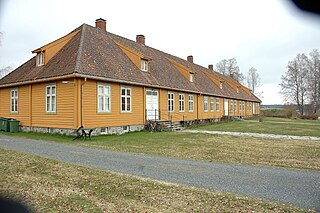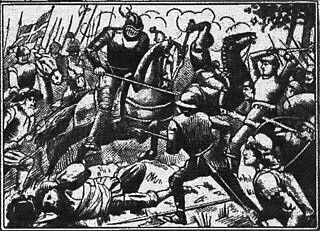As of 2019, Norway ranks 22nd in the World Economic Forum's Travel and Tourism Competitiveness Report. Tourism in Norway contributed 4.2% of the gross domestic product as reported in 2018. Every seven in a hundred people throughout the country work in the tourism industry. Tourism is seasonal in Norway, with more than half of total tourists visiting between the months of May and August.

Fredriksten is a fortress in the city of Halden in Norway.

Akershus Fortress or Akershus Castle is a medieval castle in the Norwegian capital Oslo that was built to protect and provide a royal residence for the city. Since the Middle Ages the fortress has been the namesake and centre of the main fief and later main county of Akershus, which was originally one of Norway's four main regions and which included most of Eastern Norway. The fortress itself was located within the Akershus main county until 1919, and also within the smaller Akershus sub county until 1842.

Oscarsborg Fortress is a coastal fortress in the Oslofjord, close to the town of Drøbak in Akershus County, Norway. The best known part is situated on two small islets: Nordre Kaholmen and Søndre Kaholmen. In addition, the main artillery batteries were on the island Håøya and smaller batteries were on the mainland to the west and east of the fjord. The fortress is best known for sinking the German heavy cruiser Blücher on 9 April 1940. The fortress was military territory until 2003 when it was made into a publicly available museum and resort. In 2014, Oscarsborg Fortress was given protected status.

Johan Caspar von Cicignon was a Luxembourg-born soldier and military engineer who spent most of his career in the service of Denmark–Norway. He is most associated with the reconstruction of Trondheim, Norway after the great fire of 1681.

Fortification Upgrades (1673–1675) was a re-organization of military forces and strengthening of the defenses of Norway. The Norwegian army in this period became much better prepared for conflict with Sweden than in any previous period. It numbered 12,000 men in five regiments of infantry, 6 companies of cavalry, and an artillery division with 76 field pieces. An additional Norwegian regiment was serving in Denmark.

Blaker Fortress is a former defense facility located at the village of Blaker in Akershus country, Norway.

The Great Northern War was the war fought between a coalition of Denmark–Norway, Russia and Saxony-Poland on one side and Sweden on the other side from 1700 to 1721. It started by a coordinated attack on Sweden by the coalition in 1700, and ended 1721 with the conclusion of the Treaty of Nystad, and the Stockholm Treaties. As a result of the war, Russia supplanted Sweden as the dominant power on the shores of the Baltic Sea, becoming a major player in European politics.

Sverresborg or Sverre Sigurdsson's castle was a fort and residence built in the medieval city of Nidaros by King Sverre Sigurdsson. The fortification was built in support of Sverre Sigurdsson's struggle against his rival King Magnus Erlingsson to claim the throne of Norway. The site now forms part of the Sverresborg Trøndelag Folk Museum, an open-air museum for the region of Trøndelag.
Anthony Coucheron was an engineering officer. Coucheron played an important role in the history of Norwegian and Danish fortifications. As Sweden grew to be a great power in the 17th century, there were frequent wars in the Baltic region, and conflict was common along the borders between Sweden & Denmark-Norway. Easy invasions routes from Sweden were fortified on the Danish-Norwegian border with new or upgraded fortresses during this period, effectively establishing the modern borders between Norway & Sweden. Anthony Coucheron played a major role in fortification of the border, both in Norway and Denmark in addition, he participated with honor in combat during the Gyldenløve War.

The Diocese of Oslo is an exempt Latin Church diocese of the Catholic Church located in the city of Oslo in Norway.

Caspar Herman Hausmann was a Danish-Norwegian General, lumber merchant and squire. He was born 10 January 1653 at Segeberg in the Danish duchy of Holsten, which was then in union with Denmark-Norway. He died 9 September 1718 in Christiania and lies in a crypt in Oslo Cathedral. He was married to Karen Nielsdatter Toller (1662–1742). He was a half-brother by Margaret Pape with Ulrik Frederik Gyldenløve (1638–1704) — Gyldenløve was King Frederick III of Denmark's acknowledged illegitimate son and Statholder (viceroy) to Norway from 1664 until 1699.

The Church of Jesus Christ of Latter-day Saints in Norway is a restorationist free church. There are more than 4,500 members in Norway. A temple to be built in Oslo was announced on April 4, 2021 by church President Russell M. Nelson.

The siege of Fredriksten was an attack on the Norwegian fortress of Fredriksten in the city of Fredrikshald by King Charles XII of Sweden. While inspecting his troops' lines, Charles XII was killed by a projectile. The Swedes broke off the siege, and the Norwegians held the fortress. Along with the Treaty of Nystad three years later, the death of Charles XII marked the end of the imperial era in Sweden, and the beginning of the Age of Liberty in that country.

The National Fortifications Heritage is a division with the Norwegian Defence Estates Agency responsible for sixteen military fortifications in Norway designated as heritage sites. The agency is responsible for conserving the character and history of the sites, while facilitating their use for culture, business and experiences. The list consists of ten fortresses, four smaller forts and two networks of border fortifications. Three fortresses, Akershus, Bergenshus and Vardøhus, date from the Middle Ages. Five installations date from the union with Denmark and five were built either union with Sweden or following the dissolution, as a defense against a Swedish invasion. Three forts, Austrått, Møvik and Trondenes, were built by the German Wehrmacht during World War II as part of Festung Norwegen.

The Dano-Swedish War from 1501 to 1512 was a military conflict between Denmark and Sweden within the Kalmar Union.
Allied Forces South Norway (SONOR) was a NATO command tasked with the defense of Southern Norway. SONOR's area of responsibility included all of Norway with the adjacent sea territory excluding the three northernmost counties of Norway, which were under Allied Forces North Norway.

is a town in Elverum Municipality in Innlandet county, Norway. The town is the administrative centre of the municipality. It is located in the western part of the municipality along the river Glomma, about 30 kilometres (19 mi) east of the town of Hamar. The town is the regional centre for commerce and industry for the middle Østerdalen valley and the northern part of Solør. The old village of Elverum has grown over the years and in 1996, the municipal council granted Elverum town status.















